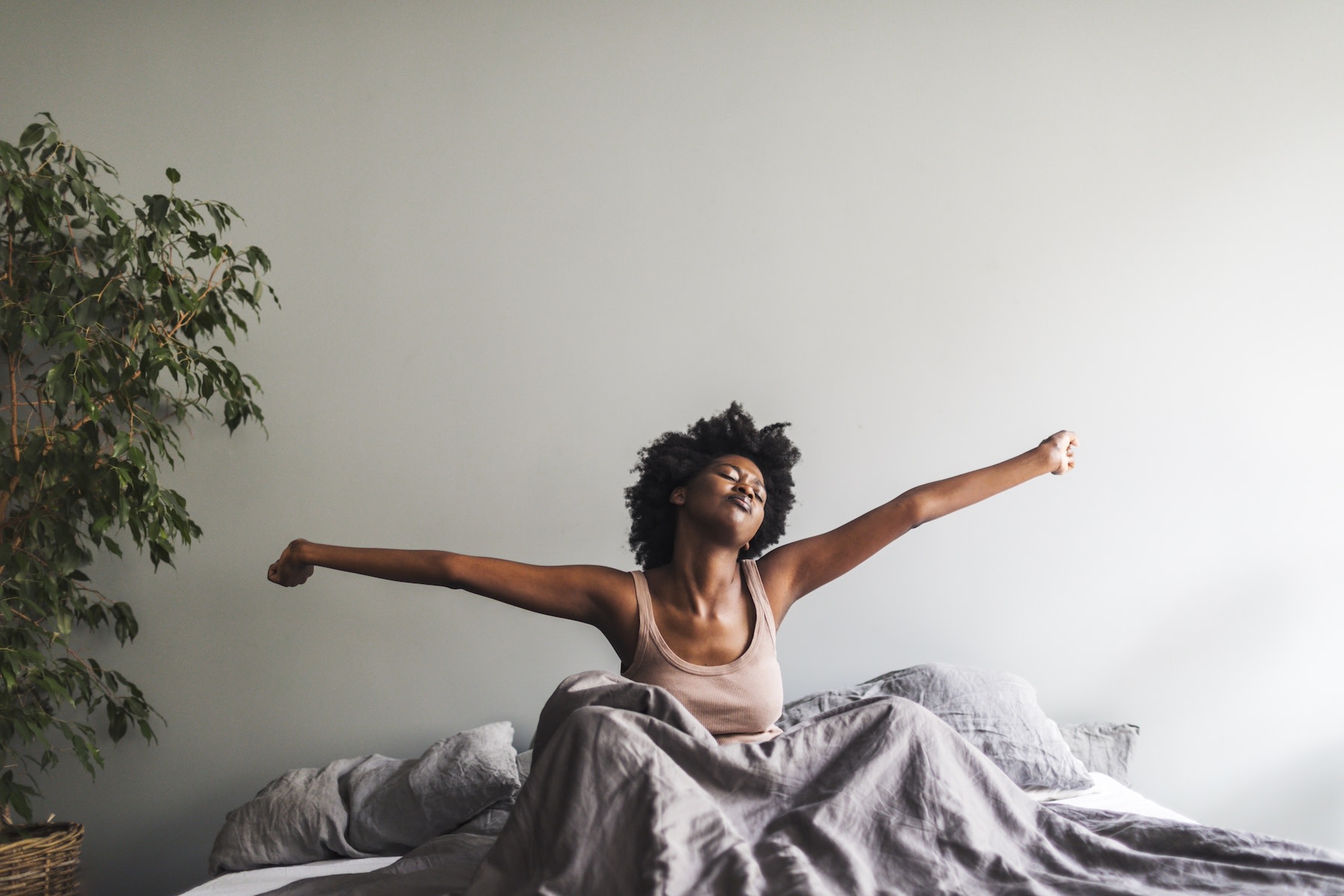
Goodboy Picture Company / E+ via Getty Images
Why Do We Instinctively Stretch When We Wake Up?
Ever wondered why you do those automatic little stretches in bed every morning? We asked experts to break it down.
By L'Oreal Thompson Payton•
Why Do We Stretch When We Wake Up?
Benefits of Stretching in the Morning
What to Do When You Want a Deeper Stretch
The Takeaway
What's the first thing you do when you wake up? Maybe you make some coffee, meditate, or check your notifications. No matter your answer, chances are you've knocked out another ritual first without realizing it: some quick morning stretching. But why do we stretch when we wake up? What makes our body perform those instinctive little stretches each morning?
Turns out, it’s something called pandiculation, which is the involuntary stretching that helps our bodies “wake up” our muscles and get blood moving before we start our day. It also feels pretty darn good after a long night’s rest.
We talked to experts to learn more about the science behind stretching and how it can help you make the most of your mornings.
Why Do We Stretch When We Wake Up?
While our bodies naturally engage in pandiculation, you likely haven’t paid close attention to it or the type of stretching your body needs most. The act of instinctively stretching upon waking up occurs for a few different reasons, according to Claudia Canales, a physical therapist at Hinge Health.
First, “when we are asleep, we aren’t moving nearly as often as when we are awake (hopefully),” Canales says. Second, “blood flow to our muscles decreases due to a decrease in heart rate, and lastly, our muscles typically experience a decrease in tone, and thus some may remain in a shortened position,” she explains. Pandiculation can help counteract those effects.
When we wake up for the day, we also want to prime our brain and our body for daily tasks that require movement. Stretching is one way to do that.
“Stretching, whether done without thought or purposefully, helps increase blood flow and oxygen to our muscles, allowing us to ‘wake’ the body up,” Canales says. “Additionally, our nervous system must also be prepped and primed for movement, so by stretching, we alert receptors of a muscle length change. These receptors are known as muscle spindles and they are responsible for alerting the brain of muscle changes and thus increasing awareness, preparing the body for movement.”
During pandiculation, the body becomes more flexible, integrated, and ready to move. We also feel more energized and have a lower likelihood of suffering injuries, explains Luiz Fernando Bertolucci, MD, a physiatrist and leading pandiculation researcher.
But if you’ve noticed you’re not instinctively stretching in the morning, there's actually a way to help your body get there. When you wake up, stay in bed for a while without moving around. “This time is important for the central nervous system to plan the proper pandiculation movement for that particular moment," he explains. Eventually, "we may feel a small willingness to move in such a way, and then we simply follow the body's needs."
With time, those instinctive stretches may become better and better at waking up your muscles. "Day by day, the spontaneous movements of pandiculation may get bigger and more comprehensive,” Dr. Bertolucci notes.
Benefits of Stretching in the Morning
There are several possible physical benefits to stretching in the morning, including:
Enhanced flexibility
Muscle activation
Increased blood circulation
Reduced tension/stress
Improved body awareness
Improved alertness
“Stretching in the morning is beneficial as it helps improve flexibility, prepare our bodies for movement, and avoid injury,” Canales explains. “Another important benefit is that it increases blood flow to the muscles, which can help with waking the body but also our brain.”
If you’re someone who works a physically demanding job or you engage in physical activities such as running, cycling, or strength training, then incorporating a stretch session as part of your morning routine is even more important.
“Morning stretching is a great way to improve mobility and help us be aware of our body's position throughout the day,” Canales says. But that doesn’t mean stretching should be done only in the morning. Stretching and moving frequently throughout the day will do your body good, Canales says.
Those morning stretches might even boost motivation levels. “Lack of proper movement lowers our motivation, as the central nervous system understands that something is not right and needs attention, much in the same way thirst signals lack of water,” Dr. Bertolucci says. “So when we pandiculate, we are increasing our capacity to move freely, and we are also rewarded with pleasure and with a higher degree of motivation.”

JulPo / E+ via Getty Images
What to Do When You Want a Deeper Stretch
Those instinctive little stretches you do each morning are great, but it’s smart to make time for a conscious, more purposeful stretching routine, too.
The American College of Sports Medicine recommends stretching at least two to three times per week. For most adults, that means holding a static stretch for 10–30 seconds, while older adults should hold it for 30–60 seconds. While daily stretching is considered most effective, it’s more important to find a routine that works for you and your schedule.
“Maintaining a regular frequency is key, so if your session lasts five minutes or 20 minutes, do what works for you,” Canales says. “To experience the long-term benefits of stretching (i.e. mobility and flexibility), it must be done consistently and frequently.”
The type of stretching that’ll be most beneficial for your body depends on the activity level you’re preparing for or winding down from. “If you want to stretch before you do a 5K, then lengthening the muscles with fast quick movements, known as dynamic stretches, to prepare your body for set activity is best,” Canales advises. “If you want to stretch to alleviate tension from a sedentary activity or to cool down after a workout, then holding stretches for a longer time, known as static stretches, can be more optimal.”
Full-body stretches are a great way to start if you’re looking for a deeper stretching routine in the morning. (You can find plenty of stretch and mobility classes on the Peloton App, including picks designed specifically for the morning.) But your stretching can also be more strategic by targeting areas in your body that tend to stiffen up or feel less mobile than others. For example, if you work behind a desk and experience low back and/or hip stiffness frequently, then focusing on those muscle groups more frequently is a great way to improve mobility and prevent injury, Canales says.
Another way to deepen your stretching routine is by incorporating deep breathing techniques. “Oftentimes, when a patient of mine is deepening a stretch, the number one thing they tend to do is hold their breath,” Canales says “This defeats the purpose, as holding one’s breath can result in more tension. Therefore, I always cue them to focus on their breathing.”
But how should you breathe during a stretch routine, exactly? Canales recommends taking a deep breath in and, as you exhale, try to melt a bit further into the stretch. Repeat until you’re in a comfortable position and can breathe easily.
The Takeaway
We stretch in the morning to help our brain and body “wake up” after a night of resting by increasing blood flow and oxygen to our muscles. This instinctive act of stretching is called “pandiculation,” and it can help our mind and muscles prepare for movement and fend off injury. While pandiculation is helpful, it can benefit you to incorporate more purposeful and consistent stretching into your routine, too. You can try full-body stretches or target specific areas in your body where you notice tension. (The Peloton App offers a wide array of stretching classes that can help you get started.)
With any new routine—including stretching—it’s important to start gradually to help prevent injury. As your body becomes accustomed to morning stretch sessions, you may experiment with the duration, frequency, and intensity of your new routine. “If your goal is to stretch in the morning three times per week, start with a five- to 10-minute session for the first couple of weeks,” Canales advises. “Once it feels more like a habit rather than a “chore,’ consider increasing time and/or frequency.”
This content is for informational and educational purposes only and does not constitute individualized advice. It is not intended to replace professional medical evaluation, diagnosis, or treatment. Seek the advice of your physician for questions you may have regarding your health or a medical condition. If you are having a medical emergency, call your physician or 911 immediately.
Get our latest health stories straight to your inbox
Enter your email to get articles, expert-backed tips, and updates from Peloton sent to your inbox.





